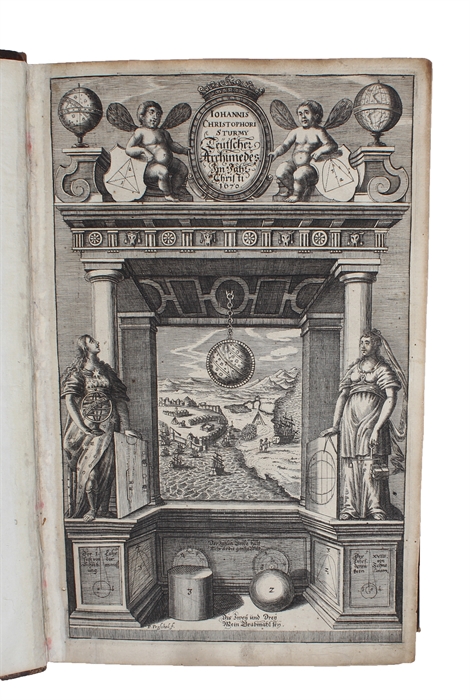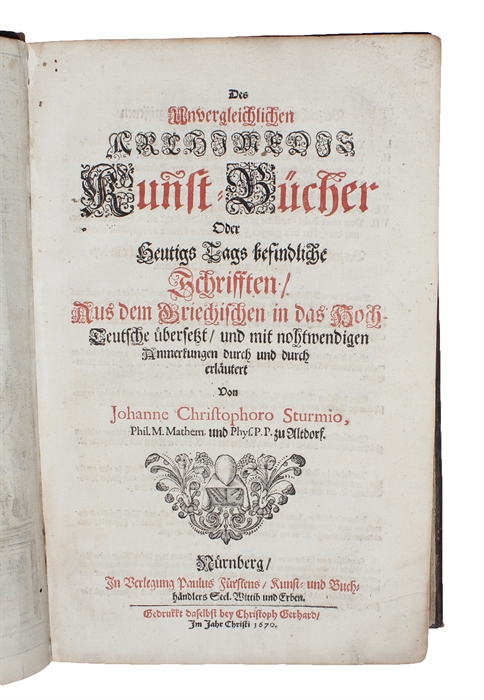FIRST GERMAN ARCHIMEDES
ARCHIMEDES OF SYRACUSE.
Des Unvergleichlichen Archimedis Kunst=Bücher Oder Heutigs Tags befindliche Schrifften, Aus dem Griechischen in das Hoch-Deutsche übersetzt, und mit nothwendigen Anmerkungen durch und durch erläutert von Johanne Christophoro Sturmio. (und) Des Unvergleichlichen Archimedis Sand=Rechnung, Oder Tiefsinnige Erfindung einer, mit verwunderlicher Leichtigkeit aussprechlichen, Zahl, welche Er unfehlbar beweiset grösser zu sein als Anzahl aller Sandkörnlein, mit welchem die Höhle der ganzen Welt, biss an den äussersten Fix-oder Haft-Sternen-Himmel könnte Ausgefüllet werden.
Nürnberg, Paulus Fürsten, 1670 (Sand=Rechnung: 1667).
Folio. Cont. full calf, rebacked in old style with 5 raised bands. Corners neatly repaired. Extremities slightly rubbed. Engraved frontispiece with globes, world-systems and archimedean figures. Title in red a. black. (18),427,(1) pp. and (8),32 pp. Numerous diagrams in the text. Occasional light browning, a few brownspots. Some leaves in the "Sand-Rechnung" with a dampstain. In general fine, printed on good paper.
First German edition of Archimedes' main mathematical works. The translation was made on the basis of David Rivault's latin-greek edition of 1615 and it has commentaries by the editor J.C. Sturm. It comprises, in first German translation, these main works of Archimedes: 1. Sphere & Cylinder (2 Books) - 2. Measurement of the Circle. - 3. Equilibrium of planes. - 4. Quadrature of the parabola. 5. Conoids & spheroids. 6. Spirals. - 7. Sand reckoner (Psammites, Arenarius) here with its own titlepage dated 1667.
The famous Sand reckoner introduced an extremely large number in arithmetics, "How many grains of sand could the whole universe hold" ?, and this work also contained the first printed statement of the heliostatic world-picture, a theory first put forward by ARISTARCHUS in a lost work and here referred by Archimedes: "Dann er fetzet (Aristarchus) die Fix-oder Haft-Sterne, samt der Sonne als unbeweglich in einem Kreiss umb die Sonne, welche das Mittel solches Kreises besitze. Der Fix-oder Haft-Sternen aber ihren umb der Sonnen Mittelpunct ausgespannten, Himmel beschreibet er in solcher Grösse, dass der Erden Lauffkreiss, auf welchem sie umb die Sonne bewegt werden solle, gegen derer Haft-Sternen fernen Entlegenheit, sich nicht anderst verhalte, als einer Kugel Mittel-punct gegen deroselben Umbkreiss." (pp. 2 -3 in Sand=Rechnung").
Archimedes was called "the God of Mathematics" by Plinius, and he is without doubt the greatest mathematician, physicist and engineer of ancient times and one of the greatest geniuses of all times. "There is no one individual whose work epitomizes the character of the Alexandrian age so well as Archimedes (287-212 B.C.), the greatest mathematician in antiquity." (Morris Kline). "He gave birth to the calculus of the infinite conceived and brought to perfection successively by Kepler, Cavalieri, Fermat, Leibnitz and Newton." (Chasles) - Poggendorff II:1043. -
Order-nr.: 34702




